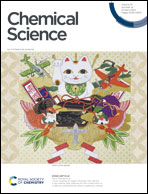Tertiary amide bond formation by an engineered asparaginyl ligase†
Abstract
Transpeptidases are powerful tools for site-specific protein modification, enabling the production of tailored biologics to investigate protein function and aiding the development of next-generation therapeutics and diagnostics. Although protein labelling at the N- or C-terminus is readily accomplished using a range of established transpeptidases, these reactions are generally limited to forming products that are linked by a standard (secondary) amide bond. Here we show that, unlike other widely used transpeptidases, an engineered asparaginyl ligase is able to efficiently synthesise tertiary amide bonds by accepting diverse secondary amine nucleophiles. These reactions proceed efficiently under mild conditions (near-neutral pH) and allow the optimal recognition elements for asparaginyl ligases (P1 Asn and P2′′ Leu) to be preserved. Certain products, particularly proline-containing products, were found to be protected from recognition by the enzyme, allowing for straightforward sequential labelling of proteins. Additionally, incorporation of 4-azidoproline enables one-pot dual labelling directly at the ligation junction. These capabilities further expand the chemical diversity of asparaginyl ligase-catalysed reactions and provide an alternative approach for straightforward, successive modification of protein substrates.



 Please wait while we load your content...
Please wait while we load your content...